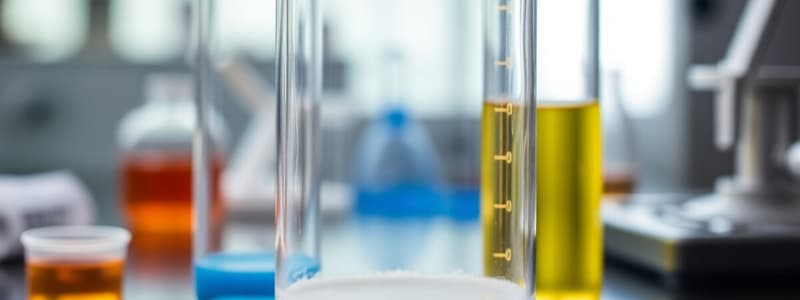Podcast
Questions and Answers
What property of water makes it effective as a solvent for ionic and polar substances?
What property of water makes it effective as a solvent for ionic and polar substances?
- Its high pH level
- Its ability to form hydrogen bonds (correct)
- Its temperature-regulating ability
- Its strong dipole nature (correct)
What is the significance of the auto-ionization of water?
What is the significance of the auto-ionization of water?
- It maintains the pH balance in biological systems (correct)
- It leads to the formation of strong acids only
- It is irrelevant in physiological processes
- It generates only hydroxide ions
Which of the following correctly describes the role of a buffer?
Which of the following correctly describes the role of a buffer?
- Buffers concentrate acids only
- Buffers are always weak bases
- Buffers perform neutralization between two strong acids
- Buffers resist changes in pH (correct)
What is the ion product constant of water (Kw) at 25ºC?
What is the ion product constant of water (Kw) at 25ºC?
Which statement correctly defines a strong acid?
Which statement correctly defines a strong acid?
How do hydrogen ions contribute to the pH of a solution?
How do hydrogen ions contribute to the pH of a solution?
What happens during the neutralization reaction between an acid and a base?
What happens during the neutralization reaction between an acid and a base?
Which characteristic of water contributes to its high boiling point compared to other substances?
Which characteristic of water contributes to its high boiling point compared to other substances?
What is the pH of a neutral solution at 25ºC?
What is the pH of a neutral solution at 25ºC?
Which ion concentration increases with a decrease in the concentration of the other ion according to the equilibrium principle?
Which ion concentration increases with a decrease in the concentration of the other ion according to the equilibrium principle?
What is the physiological pH range for most body fluids?
What is the physiological pH range for most body fluids?
Which of the following statements about strong acids is correct?
Which of the following statements about strong acids is correct?
What is the pH of gastric acid?
What is the pH of gastric acid?
How does the pH scale correspond to acidity and basicity?
How does the pH scale correspond to acidity and basicity?
What characteristic distinguishes weak acids from strong acids?
What characteristic distinguishes weak acids from strong acids?
What substance serves as the most important buffer in the human body?
What substance serves as the most important buffer in the human body?
Which of the following statements about pKa is true?
Which of the following statements about pKa is true?
Flashcards are hidden until you start studying
Study Notes
pH and Buffers
- Buffers resist changes in pH by maintaining a stable concentration of hydrogen ions (H+) in solution.
- Acid: H+ donor; Base: H+ acceptor; water (H2O) can act as both.
- Ionization of water:
- H2O ⇄ H3O+ + OH−
- Ion product constant (Kw) at 25ºC: Kw = [H+] × [OH−] = 1.0 × 10^-14 M².
- In pure water, [H+] = [OH−] = 10^-7 M, leading to a neutral pH of 7.0.
Properties of Water
- Water is essential for life, providing a medium for biochemical reactions.
- Strongly electronegative oxygen creates a strong dipole, making water a polar solvent.
- Unique properties include high surface tension and elevated boiling point.
pH Scale and Measurement
- pH is a logarithmic scale measuring [H3O+] concentration:
- pH = -log[H3O+].
- Neutral solutions have a pH of 7.0; acidic solutions are < 7.0, and basic solutions are > 7.0.
- Physiological pH range for most body fluids is 6.5 - 8.0; gastric juice has a pH of 1 – 3.
pH in Living Systems
- Gastric acid: 0.70
- Lysosomes: 4.50
- Granules of chromaffin cells: 5.50
- Urine: 6.00
- Neutral H2O (at 37°C): 6.81
- Cytosol: 7.20
- Cerebrospinal fluid (CSF): 7.30
- Blood: 7.34 – 7.45
- Mitochondrial matrix: 7.50
- Pancreas secretions: 8.10
Ionization of Acids and Bases
- Strong acids completely ionize, while weak acids partially ionize in solutions.
- Weak acids and bases establish equilibrium with their conjugate forms.
- Dissociation constant (Ka) for acids:
- Ka = [H+] × [A−] / [HA]; pKa = -log(Ka).
- A smaller pKa indicates a stronger acid.
Buffers
- Buffers consist of a weak acid or a weak base and its salt.
- They minimize pH changes upon the addition of small amounts of acids or bases.
- Bicarbonate is a crucial buffer in the human body, maintaining physiological pH.
Studying That Suits You
Use AI to generate personalized quizzes and flashcards to suit your learning preferences.



